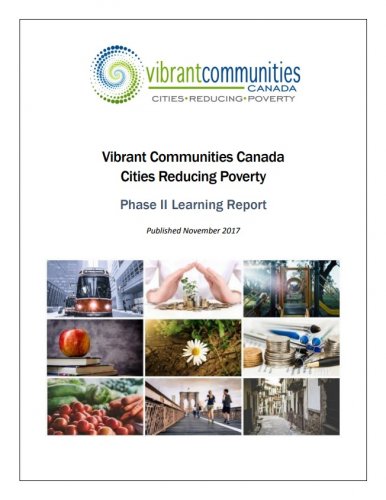The most recent iteration of the Communities Reducing Poverty (CRP) shared evaluation process was launched in 2016 in attempt to address the capacity challenges that CRP members had previously reported. The evaluation was administered over two phases.
First, a Phase I survey was released online in April 2016 and was completed by 88% of CRP members. The Phase I survey data allowed Vibrant Communities to compile an aggregate profile of CRP members’ poverty reduction initiatives across Canada with respect to their governance structures, partnerships, resources, priorities, and more.
Second, a Phase II survey was launched online in December 2016. The objective of this survey was to capture contributions and outcomes of local poverty reduction initiatives across the country across three impact areas: program delivery, policy change, and systems change. CRP staff encouraged, supported, and followed up with CRP members to complete the online Phase II survey. Where additional support was requested, CRP staff walked CRP members through the survey over the phone. In the end, 40 eligible members completed it for an overall response rate of 87%.
This report highlights examples of success from within the CRP network with regard to programs, policy change, and systems change that contribute to poverty reduction. It was written primarily for CRP members, to help their local stakeholders build an understanding of the impactful poverty reduction work that is happening across the country, and to inspire learning and action.
- Part 2 of this report describes how the Phase II survey was developed.
- Part 3 provides an overview of the key findings that emerged from Phase II survey data.
- Part 4 detailed results from the Phase II survey.
- Part 5 discusses implications of our findings, including how CRP members, partners, and CRP staff can use this report to inform our work.
- Part 6 acknowledges CRP members’ contributions to the Phase II survey.
Table of Contents
Section 1 Introduction
1.1 Cities Reducing Poverty (CRP)
1.2 Learning About Outcomes
1.3 How to Read this Report
Section 2 Methodology
2.1 Design of Phase II
2.2 The Phase II Survey
Section 3 Overview of Key Findings
Section 4 Results
4.1 Grouping #1 – Programs and Innovations
4.1.1 Introduction
4.1.2 Education: Increasing uptake of the Canada Learning Bond
4.1.3 Income and Employment: Implementing Living Wage policies
4.1.4 Housing: Generating rent and utility banks
4.1.5 Transportation: Building rural bus networks and services
4.1.6 Financial Empowerment: Delivering affordable and inclusive financial products
4.1.7 Conclusion
4.2 Grouping #2 – Policy Change
4.2.1 Introduction
4.2.2 Housing: Implementing Housing First strategies
4.2.3 Transportation: Creating affordable transportation passes
4.2.4 Education: Improving access to post-secondary education
4.2.5 Early Childhood Development: Investing in childcare
4.2.6 Financial Empowerment: Regulating payday loans
4.2.7 Conclusion
4.3 Grouping #3 – Systems change
4.3.1 Introduction
4.3.2 Coordinating and streamlining programs and service delivery
4.3.3 Enhancing multi-sectoral partnerships and collaboration
4.3.4 Initiating action-oriented teams to facilitate the design and delivery of supports
4.3.5 Creating opportunities for people with lived experience to shape programs
4.3.6 Mobilizing funding and funding reforms
4.3.1 Conclusion
Section 5 Conclusion
5.1 Implications for CRP Members and Partners
5.2 Implications for CRP Learning Opportunities
5.3 Implications for CRP Staff
5.4 Final Words
Section 6 Acknowledgements
Appendix I: VC’s Game Changer Approach to Poverty Reduction Strategy and Evaluation
Format
Theme





